 As summer winds down, and cooler weather seems headed our way, youngsters and adults prepare to say a last hoorah to the blissfully warm days of summer and head into the crisp days of fall. With winter not far behind autumn, readers may take comfort in the knowledge that while there is a time and a season for everything, every season provides a reason to read. This week’s reviews from members of the International Reading Association's Children's Literature and Reading Special Interest Group focus on seasonal favorites that shift our lives to an autumnal mode featuring thoughts of harvests and plans to get ready for the rest of the year. It might be a good time to visit the local library or bookstore and harvest a few books of your own for future enjoyment. ReadWriteThink offers a wide range of lesson ideas on the seasons that include rhyming poems and songs as well as fiction and nonfiction reads that will keep young readers engrossed as the seasons change.
As summer winds down, and cooler weather seems headed our way, youngsters and adults prepare to say a last hoorah to the blissfully warm days of summer and head into the crisp days of fall. With winter not far behind autumn, readers may take comfort in the knowledge that while there is a time and a season for everything, every season provides a reason to read. This week’s reviews from members of the International Reading Association's Children's Literature and Reading Special Interest Group focus on seasonal favorites that shift our lives to an autumnal mode featuring thoughts of harvests and plans to get ready for the rest of the year. It might be a good time to visit the local library or bookstore and harvest a few books of your own for future enjoyment. ReadWriteThink offers a wide range of lesson ideas on the seasons that include rhyming poems and songs as well as fiction and nonfiction reads that will keep young readers engrossed as the seasons change.
GRADES K-3
Bean, Jonathan. (2013). Building our house. New York, NY: Farrar, Straus and Giroux.
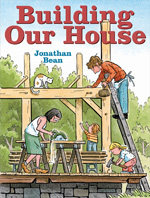 Longing for a home of their own, a do-it-yourself family buys a plot of land on which to build the place in which they’ve always dreamed of living. While they work on the project little by little, as they have time, they live in a trailer located on their new property. The illustrations are filled with details showing each step in the building process, from the gathering of rocks for the house’s foundation to the filling of its interior with furniture and personal keepsakes. Because each illustration shows the movement of time and the changing of seasons, readers are able to witness the slow but steady progress the family makes during the year and a half it takes to build the house. Readers will smile as the watch how the family continues to grow as time goes by, even adding a baby and a stray cat and kittens. The author/illustrator based the book on his own family’s experiences, and the afterword with photographs of the author's family hard at work adds to the book's appeal.
Longing for a home of their own, a do-it-yourself family buys a plot of land on which to build the place in which they’ve always dreamed of living. While they work on the project little by little, as they have time, they live in a trailer located on their new property. The illustrations are filled with details showing each step in the building process, from the gathering of rocks for the house’s foundation to the filling of its interior with furniture and personal keepsakes. Because each illustration shows the movement of time and the changing of seasons, readers are able to witness the slow but steady progress the family makes during the year and a half it takes to build the house. Readers will smile as the watch how the family continues to grow as time goes by, even adding a baby and a stray cat and kittens. The author/illustrator based the book on his own family’s experiences, and the afterword with photographs of the author's family hard at work adds to the book's appeal.
- Barbara A. Ward, Washington State University Pullman
Berkes, Marianne. (2013). What’s in the garden? Illus. by Cris Arbo. Nevada City, CA: Dawn Publications.
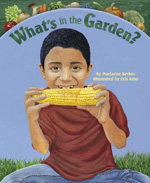 Late summer and early fall are the perfect times to reap the benefits of a good garden, and this book does just that. Starting with a rhyming riddle, readers are queried to guess the described garden item. The following page gives the answer, along with a recipe. The opening riddle describes an apple, and the very simple recipe gives the steps for making applesauce. Lettuce comes next with the recipe for a mixed green salad. The illustrations opposite the recipe page show the plant as it looks in the soil just before it is time to harvest, giving young readers a sense of gardening from start to finish. Other food plants include carrots, broccoli, blueberries, celery, tomatoes, cucumbers, onions, potatoes, corn, and pumpkins. Several pages at the end of the book include even more facts about growing food. Throughout the book, children from a variety of cultures are featured with the garden food to provide a beautiful multicultural backdrop.
Late summer and early fall are the perfect times to reap the benefits of a good garden, and this book does just that. Starting with a rhyming riddle, readers are queried to guess the described garden item. The following page gives the answer, along with a recipe. The opening riddle describes an apple, and the very simple recipe gives the steps for making applesauce. Lettuce comes next with the recipe for a mixed green salad. The illustrations opposite the recipe page show the plant as it looks in the soil just before it is time to harvest, giving young readers a sense of gardening from start to finish. Other food plants include carrots, broccoli, blueberries, celery, tomatoes, cucumbers, onions, potatoes, corn, and pumpkins. Several pages at the end of the book include even more facts about growing food. Throughout the book, children from a variety of cultures are featured with the garden food to provide a beautiful multicultural backdrop.
- Karen Hildebrand, Ohio Library and Reading Consultant
Chernesky, Felicia Sanzari. (2013). Pick a circle, gather squares: A fall harvest of shapes. Illus. by Susan Swan. New York, NY: Albert Whitman & Company.
 Visiting farm markets and fall festivals with her family inspired the author to write this rhymed picture book about fall, which is the first in a series of books from the publisher. Father, son, and daughter are on a hayride visit to the pumpkin patch. Along the way, they observe all kinds of autumnal objects and sources for shapes. The author/illustrator team goes beyond basic shapes like circles and squares to include ovals, hexagons, triangles, and more. Swan’s use of texture through paper-cut collages, filigree, wood grain, and photographs add a vibrant touch to the text. Beginning readers will appreciate that the shape words and their counterparts are in bold print and teachers will enjoy the addition of a mathematical introduction to geometric shapes with a fall theme. Watch for the 2014 release of the companion book, Cheers for a Dozen Ears: A Summer Crop of Counting.
Visiting farm markets and fall festivals with her family inspired the author to write this rhymed picture book about fall, which is the first in a series of books from the publisher. Father, son, and daughter are on a hayride visit to the pumpkin patch. Along the way, they observe all kinds of autumnal objects and sources for shapes. The author/illustrator team goes beyond basic shapes like circles and squares to include ovals, hexagons, triangles, and more. Swan’s use of texture through paper-cut collages, filigree, wood grain, and photographs add a vibrant touch to the text. Beginning readers will appreciate that the shape words and their counterparts are in bold print and teachers will enjoy the addition of a mathematical introduction to geometric shapes with a fall theme. Watch for the 2014 release of the companion book, Cheers for a Dozen Ears: A Summer Crop of Counting.
- Karen Hildebrand, Ohio Library and Reading Consultant
Gregory, Helen. (2013). Harvest season. North Mankato, MN: Capstone Press.
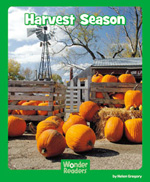 From the Wonder Reader series, bold and enlarged text makes this perfect for early readers. In addition, teachers looking for early social studies connections will appreciate this book. A paragraph on the Table of Contents page relates the national social studies standards as well as suggesting that “…these titles use text structures that support early readers specifically with a close photo/text match and glossary.” Each double page spread has detailed illustrations to first explain harvesting and then provide simple statements to explain the process to pick the featured fruit or vegetable. Featured are strawberries, apples, potatoes, pumpkins, wheat, and corn and concluding with a glossary and suggested reading and activities.
From the Wonder Reader series, bold and enlarged text makes this perfect for early readers. In addition, teachers looking for early social studies connections will appreciate this book. A paragraph on the Table of Contents page relates the national social studies standards as well as suggesting that “…these titles use text structures that support early readers specifically with a close photo/text match and glossary.” Each double page spread has detailed illustrations to first explain harvesting and then provide simple statements to explain the process to pick the featured fruit or vegetable. Featured are strawberries, apples, potatoes, pumpkins, wheat, and corn and concluding with a glossary and suggested reading and activities.
- Karen Hildebrand, Ohio Library and Reading Consultant
Himmelman, John. (2013). Noisy frog sing-along. Nevada City, CA: Dawn Publications.
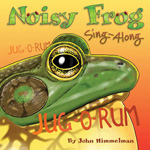 The various sounds made by frogs make this book a sonic delight. From the sounds of a peeper to the occasional "meep meep meep" (unpaged) of a tree frog, the author makes it clear just how noisy frogs can be and how prevalent their sounds may be as the seasons change, and they prepare to hibernate. The illustrations and the book’s pages, filled with frog calls, are appealing to the eyes and sure to prompt mimicry. Additional facts about the various frogs highlighted in the book can be found in the back matter. Young readers will be interested to know that only male frogs provide the vocalizing that fills the air waves. Listen to frog calls and see the book's activity guide on the publisher's website.
The various sounds made by frogs make this book a sonic delight. From the sounds of a peeper to the occasional "meep meep meep" (unpaged) of a tree frog, the author makes it clear just how noisy frogs can be and how prevalent their sounds may be as the seasons change, and they prepare to hibernate. The illustrations and the book’s pages, filled with frog calls, are appealing to the eyes and sure to prompt mimicry. Additional facts about the various frogs highlighted in the book can be found in the back matter. Young readers will be interested to know that only male frogs provide the vocalizing that fills the air waves. Listen to frog calls and see the book's activity guide on the publisher's website.
- Barbara A. Ward, Washington State University Pullman
Holland, Mary. (2013). Ferdinand Fox’s first summer. Mount Pleasant, SC: Sylvan Dell Publishing.
 Filled with memorable photographs of a young fox taken up close, this book follows one fox, Ferdinand, as he grows up. Venturing out of his den when he is five weeks old, Ferdinand learns to hunt by playing with his fellow kits. With text that is just as engaging as the excellent photographs, the book describes and shows how the mother fox weans her young so that they learn to rely on their own abilities as hunters. The book also features activities related to foxes for anyone who wants to learn more or show off what he/she has learned. Readers should look closely at the photographs and notice the fox’s habitat so they can spot signs of a grown-up Ferdinand this fall and winter. The publisher's website has a video about this author/photographer. Readers will surely be curious to learn more about the habits of foxes after finishing this title and marveling at the photographer’s terrific shots.
Filled with memorable photographs of a young fox taken up close, this book follows one fox, Ferdinand, as he grows up. Venturing out of his den when he is five weeks old, Ferdinand learns to hunt by playing with his fellow kits. With text that is just as engaging as the excellent photographs, the book describes and shows how the mother fox weans her young so that they learn to rely on their own abilities as hunters. The book also features activities related to foxes for anyone who wants to learn more or show off what he/she has learned. Readers should look closely at the photographs and notice the fox’s habitat so they can spot signs of a grown-up Ferdinand this fall and winter. The publisher's website has a video about this author/photographer. Readers will surely be curious to learn more about the habits of foxes after finishing this title and marveling at the photographer’s terrific shots.
- Barbara A. Ward, Washington State University, Pullman
Hopkins, H. Joseph. (2013). The tree lady. Illus. by Jill McElmurry. New York, NY: Simon & Schuster/Beach Lane Books.
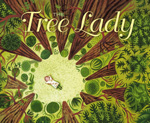 Threading a version of the repeated phrase "But Kate did" (unpaged) throughout the narrative to punctuate the subject’s determination not to conform to what others expected, this picture book biography provides ready evidence of what one person can do to change the world. Surrounded by enormous forests whose trees brought to mind “giant umbrellas that sheltered her and the animals” (unpaged), Kate Sessions grew up during the 1860s when females weren't supposed to get their hands dirty or study science. Rebelling against societal expectations, she did both, graduating with a science degree, and moving from northern California to teach in a virtually-treeless San Diego. She eventually became a gardener there and changed the appearance of the city as she searched for and planted trees that would thrive in the city’s particular environment. When planners wanted more trees for a huge exposition, Kate and her volunteers lent a hand and held parties for planting trees. The gouache illustrations display the inviting and soothing nature of these marvelous trees and the never-say-quit spirit of the woman who helped fashion Balboa Park into the green space it now is. As the summer season winds down, it’s appropriate to give thanks for all the trees around us and marvel at the determination of one visionary woman able to see green possibilities where others saw none.
Threading a version of the repeated phrase "But Kate did" (unpaged) throughout the narrative to punctuate the subject’s determination not to conform to what others expected, this picture book biography provides ready evidence of what one person can do to change the world. Surrounded by enormous forests whose trees brought to mind “giant umbrellas that sheltered her and the animals” (unpaged), Kate Sessions grew up during the 1860s when females weren't supposed to get their hands dirty or study science. Rebelling against societal expectations, she did both, graduating with a science degree, and moving from northern California to teach in a virtually-treeless San Diego. She eventually became a gardener there and changed the appearance of the city as she searched for and planted trees that would thrive in the city’s particular environment. When planners wanted more trees for a huge exposition, Kate and her volunteers lent a hand and held parties for planting trees. The gouache illustrations display the inviting and soothing nature of these marvelous trees and the never-say-quit spirit of the woman who helped fashion Balboa Park into the green space it now is. As the summer season winds down, it’s appropriate to give thanks for all the trees around us and marvel at the determination of one visionary woman able to see green possibilities where others saw none.
- Barbara A. Ward, Washington State University Pullman
LaPenta, Marilyn. (2013). Fall shakes to harvest bakes. New York, NY: Bearport Publishers.
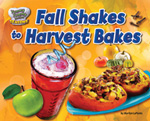 For the young cooks in the kitchen, this book of recipes includes foods that use ingredients from the fall season. All of the ingredients are healthy and nutritious although the book is very subtle about mentioning that. More nutritional information can be found at the end of the book in a section labeled “Healthy Tips.” Baked Stuffed Apples, Pumpkin Muffins, Kale Chips and Warm Cranberry Punch are just a few of the appetizing food temptations with a feel for autumn.
For the young cooks in the kitchen, this book of recipes includes foods that use ingredients from the fall season. All of the ingredients are healthy and nutritious although the book is very subtle about mentioning that. More nutritional information can be found at the end of the book in a section labeled “Healthy Tips.” Baked Stuffed Apples, Pumpkin Muffins, Kale Chips and Warm Cranberry Punch are just a few of the appetizing food temptations with a feel for autumn.
- Karen Hildebrand, Ohio Library and Reading Consultant
McNamara, Margaret. (2013). The apple orchard riddle. Illus. by G. Brian Karas. New York, NY: Random House/Schwartz & Wade.
 The youngsters in Mr. Tiffin’s class head off on a field trip to an apple orchard. Not only do the children have the chance to learn about apples, but they pick several and get to eat them. While they enjoy the tour and the fruit, their teacher has posed a riddle for them to solve. To the surprise of her classmates, it is dreamy, observant Tara who figures out the answer. The book encourages multiple responses, including heightened awareness for noticing the world around you and avoiding making assumptions about others. Residents of states filled with apple orchards, including Washington State, known for its delicious fruit, will be especially delighted with the story and the gouache, acrylic and pencil illustrations of apples, including the always-delicious Fuji, on the book’s end papers. There are even additional apples facts included in the back matter.
The youngsters in Mr. Tiffin’s class head off on a field trip to an apple orchard. Not only do the children have the chance to learn about apples, but they pick several and get to eat them. While they enjoy the tour and the fruit, their teacher has posed a riddle for them to solve. To the surprise of her classmates, it is dreamy, observant Tara who figures out the answer. The book encourages multiple responses, including heightened awareness for noticing the world around you and avoiding making assumptions about others. Residents of states filled with apple orchards, including Washington State, known for its delicious fruit, will be especially delighted with the story and the gouache, acrylic and pencil illustrations of apples, including the always-delicious Fuji, on the book’s end papers. There are even additional apples facts included in the back matter.
- Barbara A. Ward, Washington State University Pullman
Manceau, Edouard. (2013). Windblown. Translated by Sarah Quinn. Toronto, Canada: Owlkids.
 This simple yet compelling picture book, first written in French, brings a tale of windblown fantasy. When seven colored pieces of paper blow onto the page beginning with one tiny scrap of paper and then another and another the text questions where did they come from? Whose are they? First, the chicken claims them and the scraps form his eyes and beak and comb. Next, the fish says they are his as his eyes and fins take shape from the paper scraps. The bird chirps next that they are his and then on to the snail and frog. Each claims the pieces of paper until the wind quietly comes back and blows the papers on to the next adventure. The text ends by stating, “They’re yours now too. What will you do?” This ending leaves this story wide open for teachers to use cut paper scraps (or tangrams) to students to design their own creations. Watch the Vimeo storytime of some new creations after reading Windblown or download the pieces used in the book at the Owlkids website.
This simple yet compelling picture book, first written in French, brings a tale of windblown fantasy. When seven colored pieces of paper blow onto the page beginning with one tiny scrap of paper and then another and another the text questions where did they come from? Whose are they? First, the chicken claims them and the scraps form his eyes and beak and comb. Next, the fish says they are his as his eyes and fins take shape from the paper scraps. The bird chirps next that they are his and then on to the snail and frog. Each claims the pieces of paper until the wind quietly comes back and blows the papers on to the next adventure. The text ends by stating, “They’re yours now too. What will you do?” This ending leaves this story wide open for teachers to use cut paper scraps (or tangrams) to students to design their own creations. Watch the Vimeo storytime of some new creations after reading Windblown or download the pieces used in the book at the Owlkids website.
- Karen Hildebrand, Ohio Library and Reading Consultant
Marlow, Layn. (2013). You make me smile. New York, NY: Holiday House.
 There’s something appealing about the first snowfall of the year, and for many, winter is their favorite season of all. After swaddling herself in hat, gloves, boots, and scarf, a little girl heads out to enjoy the winter wonderland waiting outside her door. As many of us might do, she tenderly fashions a snowman, and comes to consider him her new friend since they’ve spent so much of the time together. Her thoughtful father captures a photograph of the two of them since he knows that snow and snow friends don’t last forever. The photograph helps remind the child that even though winter may turn to spring, and spring to summer, eventually winter will come again, as will her snowy friend. The lovely, soft-colored illustrations fit the book's tender message perfectly.
There’s something appealing about the first snowfall of the year, and for many, winter is their favorite season of all. After swaddling herself in hat, gloves, boots, and scarf, a little girl heads out to enjoy the winter wonderland waiting outside her door. As many of us might do, she tenderly fashions a snowman, and comes to consider him her new friend since they’ve spent so much of the time together. Her thoughtful father captures a photograph of the two of them since he knows that snow and snow friends don’t last forever. The photograph helps remind the child that even though winter may turn to spring, and spring to summer, eventually winter will come again, as will her snowy friend. The lovely, soft-colored illustrations fit the book's tender message perfectly.
- Barbara A. Ward, Washington State University Pullman
Marlowe, Sara. (2013). No ordinary apple: A story about eating mindfully. Illus. by Philip Pascuzzo. Somerville, MA: Wisdom Publications.
 Elliot arrives at his neighbor Carmen’s house after school. He is looking for a snack and when Carmen offers him an apple, he is NOT happy. He was thinking more along the lines of candy. Now Carmen guides Elliot through a new way of looking and sensing an apple – a more mindful way. First, she tells him to think about the colors of an apple – not just red, but green and brown as well. Touching an apple proves that they are not completely smooth, but bumpy in some parts. When Carmen has Elliot roll a piece of apple around on his tongue, she has him think about and discover how the apple tastes on different places on his tongue. Bright colorful illustrations add to the overall beauty of not only the apple but also the book itself. If reading this aloud, have a bowl of apple slices ready to try this experience with young readers. Teachers might like to use this musical book trailer to introduce Elliott and his apple or learn more about the background information to this book including downloadable coloring pictures at Mindful Families.
Elliot arrives at his neighbor Carmen’s house after school. He is looking for a snack and when Carmen offers him an apple, he is NOT happy. He was thinking more along the lines of candy. Now Carmen guides Elliot through a new way of looking and sensing an apple – a more mindful way. First, she tells him to think about the colors of an apple – not just red, but green and brown as well. Touching an apple proves that they are not completely smooth, but bumpy in some parts. When Carmen has Elliot roll a piece of apple around on his tongue, she has him think about and discover how the apple tastes on different places on his tongue. Bright colorful illustrations add to the overall beauty of not only the apple but also the book itself. If reading this aloud, have a bowl of apple slices ready to try this experience with young readers. Teachers might like to use this musical book trailer to introduce Elliott and his apple or learn more about the background information to this book including downloadable coloring pictures at Mindful Families.
- Karen Hildebrand, Ohio Library and Reading Consultant
Matheson, Christie. (2013). Tap the magic tree. New York, NY: Greenwillow Books.
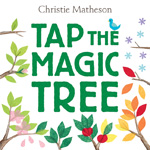 Readers will be reminded of Herve Tullet’s Press Here (2011) picture book in the style of interactive motions needed to read the book. In reading about the magic tree, young readers are asked to tap on the page and a leaf appears “magically” on the next page. As the book continues, readers will tap and shake and brush and clap to watch the apple tree change through the seasons. Vibrant colors and lots of white space add to the visual appeal along with simple text as the tree changes through the seasons. Preschool story hours will enjoy this book or parents who have a child on their lap.
Readers will be reminded of Herve Tullet’s Press Here (2011) picture book in the style of interactive motions needed to read the book. In reading about the magic tree, young readers are asked to tap on the page and a leaf appears “magically” on the next page. As the book continues, readers will tap and shake and brush and clap to watch the apple tree change through the seasons. Vibrant colors and lots of white space add to the visual appeal along with simple text as the tree changes through the seasons. Preschool story hours will enjoy this book or parents who have a child on their lap.
- Karen Hildebrand, Ohio Library and Reading Consultant
Minor, Wendell. (2013). How big could your pumpkin grow? New York, NY: Penguin Young Readers Group/Nancy Paulsen Books.
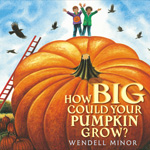 Wendell Minor has had fun with imaginative pumpkins illustrated in watercolor and gouache paintings that bring his pumpkins to life. Pumpkin festivals and contests have become so popular across the country that Minor has placed familiar American landmarks with enormous pumpkins highlighting the landscape. As readers move through the landscapes each pumpkin picture gets a bit more exaggerated and a bit more fun until finally the pumpkins are enormous finally towering on the Brooklyn Bridge, smiling at a rocket whizzing out of Cape Canaveral or the concluding pumpkin looming over the Grand Canyon. He concludes the story identifying all of the 14 landmarks included in the book with a few facts about each one. Enjoy this lively book trailer produced by the publisher as a way to introduce the book. In addition, visit the author’s website to view many of the pictures from the book … and more.
Wendell Minor has had fun with imaginative pumpkins illustrated in watercolor and gouache paintings that bring his pumpkins to life. Pumpkin festivals and contests have become so popular across the country that Minor has placed familiar American landmarks with enormous pumpkins highlighting the landscape. As readers move through the landscapes each pumpkin picture gets a bit more exaggerated and a bit more fun until finally the pumpkins are enormous finally towering on the Brooklyn Bridge, smiling at a rocket whizzing out of Cape Canaveral or the concluding pumpkin looming over the Grand Canyon. He concludes the story identifying all of the 14 landmarks included in the book with a few facts about each one. Enjoy this lively book trailer produced by the publisher as a way to introduce the book. In addition, visit the author’s website to view many of the pictures from the book … and more.
- Karen Hildebrand, Ohio Library and Reading Consultant
Stein, David Ezra. (2013). Ol' Mama Squirrel. New York, NY: Penguin Young Readers Group/Nancy Paulsen Books.
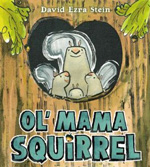 In this delightful and humorous picture book, readers meet a determined Mama Squirrel. She will not let anyone grab the kids under her watch – “Chook, chook, chook!” (unpaged). Kittens, owls, dogs, kites stuck on a tree, or even airplanes all get the same scolding. They all go away. She even scares and scolds the man who comes to prune a tree – “Chook, chook, chook!” (unpaged). Until one afternoon a growling grizzly bear comes to town. He climbs up Mama Squirrel's tree. Mama springs into action with all the items in her arsenal. But the bulky bear smiles and sends shivers through Mama's whiskers. What can Mama Squirrel to do? The bold diagrams and action packed texts will be a great text for participatory reading in the classrooms. The book is engaging and should be a popular choice in classrooms and libraries. View the publisher's book trailer and read more about the author in "5 Questions With... David Ezra Stein" on the Engage blog.
In this delightful and humorous picture book, readers meet a determined Mama Squirrel. She will not let anyone grab the kids under her watch – “Chook, chook, chook!” (unpaged). Kittens, owls, dogs, kites stuck on a tree, or even airplanes all get the same scolding. They all go away. She even scares and scolds the man who comes to prune a tree – “Chook, chook, chook!” (unpaged). Until one afternoon a growling grizzly bear comes to town. He climbs up Mama Squirrel's tree. Mama springs into action with all the items in her arsenal. But the bulky bear smiles and sends shivers through Mama's whiskers. What can Mama Squirrel to do? The bold diagrams and action packed texts will be a great text for participatory reading in the classrooms. The book is engaging and should be a popular choice in classrooms and libraries. View the publisher's book trailer and read more about the author in "5 Questions With... David Ezra Stein" on the Engage blog.
- Rani Iyer, Washington State University Pullman
Teague, Mark. (2013). The three little pigs and the somewhat bad wolf. New York, NY: Scholastic/Orchard Books.
 Perfect to read aloud more than once, this hilarious version of the classic story about three pigs and a wolf has a couple of interesting takes on the plight of its characters. After a farmer gives his pigs severance pay since he is selling the farm, the three make very different choices. As is the case in the classic story on which this one is based, the first two are lazier than the other one and more interested in spending their money on snacks. Not concerned with the future, they fashion houses out of inexpensive materials. The third pig spends all her money on bricks, and builds a structurally sound house. A hungry wolf comes along, looking for the closest fast food spot that is open since they all seem to be closed. Young readers will love the story and its ending as well as the liberty the author has taken with the familiar tale that reminds readers to prepare shelter for coming seasons. Not only will they enjoy looking at the oil painting illustrations, but they'll howl in glee when they hear that the wolf "HUFF-HUFF-PUFFED AND PUFF-HUFF-HUFFED AND HUFFY-HUFFY-PUFF-HUFFED" (unpaged) and passed out from exertion and extreme hunger. The endpapers, filled with thumbnail sketches of the pigs and the starving wolf, are particularly pleasing.
Perfect to read aloud more than once, this hilarious version of the classic story about three pigs and a wolf has a couple of interesting takes on the plight of its characters. After a farmer gives his pigs severance pay since he is selling the farm, the three make very different choices. As is the case in the classic story on which this one is based, the first two are lazier than the other one and more interested in spending their money on snacks. Not concerned with the future, they fashion houses out of inexpensive materials. The third pig spends all her money on bricks, and builds a structurally sound house. A hungry wolf comes along, looking for the closest fast food spot that is open since they all seem to be closed. Young readers will love the story and its ending as well as the liberty the author has taken with the familiar tale that reminds readers to prepare shelter for coming seasons. Not only will they enjoy looking at the oil painting illustrations, but they'll howl in glee when they hear that the wolf "HUFF-HUFF-PUFFED AND PUFF-HUFF-HUFFED AND HUFFY-HUFFY-PUFF-HUFFED" (unpaged) and passed out from exertion and extreme hunger. The endpapers, filled with thumbnail sketches of the pigs and the starving wolf, are particularly pleasing.
- Barbara A. Ward, Washington State University Pullman
Wright, Johanna. (2013). Bunnies on ice. New York, NY: Roaring Book Press.
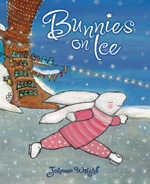 What season would a champion ice skater wait for? Just the right season, of course! In this book, narrated in a humorous voice, the author takes us through the long and laborious wait for the perfect season to skate. After eating an enormous meal, a champion's breakfast, the bunny prepares to go out and skate. The preparation is meticulous--putting on layers of clothes, and going out to perform to an audience that is filled with fans. Spin, figure-8, and leap in air. The consequences are humorous. Thankfully, the ice skater has an excellent support team who salvages the situation with plenty of hot chocolate, balanced diet, and seeks to provide ways to keep muscles loose. Finally, all champions need rest to prepare for practice the next day. The bold pictures in matt finish and subtle expressions add a touch of humor.
What season would a champion ice skater wait for? Just the right season, of course! In this book, narrated in a humorous voice, the author takes us through the long and laborious wait for the perfect season to skate. After eating an enormous meal, a champion's breakfast, the bunny prepares to go out and skate. The preparation is meticulous--putting on layers of clothes, and going out to perform to an audience that is filled with fans. Spin, figure-8, and leap in air. The consequences are humorous. Thankfully, the ice skater has an excellent support team who salvages the situation with plenty of hot chocolate, balanced diet, and seeks to provide ways to keep muscles loose. Finally, all champions need rest to prepare for practice the next day. The bold pictures in matt finish and subtle expressions add a touch of humor.
- Rani Iyer, Washington State University, Pullman
GRADES 3-5
Kline, Lisa Williams. (2013). Seasons of change. Grand Rapids, MI: Zonderkidz.
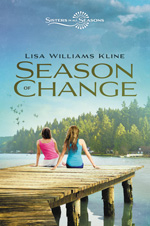 This is the final book in the nine-book series, Sisters in All Seasons. Told in alternating chapters from the two stepsisters, Diana and Stephanie, the girls have had a very difficult time becoming a blended family. When their parents, Norm and Lynn, leave for a weekend marriage counseling retreat, the teen girls begin to have concerns about another divorce. Neither wants to re-experience the emotional trauma that goes along with splitting up a family. It has been arranged for the girls to spend the weekend with Lynn’s parents. A few mishaps during the weekend include Stephanie hitting a deer when she is driving and unexpectedly her mother arrives home taking Stephanie with her. Now the two stepsisters are separated and really concerned about their own behavior toward each other and the family dynamics that may be falling apart. How a family works together and with great family role models in the form of the grandparents gives each of these characters room for thought to salvage this family.
This is the final book in the nine-book series, Sisters in All Seasons. Told in alternating chapters from the two stepsisters, Diana and Stephanie, the girls have had a very difficult time becoming a blended family. When their parents, Norm and Lynn, leave for a weekend marriage counseling retreat, the teen girls begin to have concerns about another divorce. Neither wants to re-experience the emotional trauma that goes along with splitting up a family. It has been arranged for the girls to spend the weekend with Lynn’s parents. A few mishaps during the weekend include Stephanie hitting a deer when she is driving and unexpectedly her mother arrives home taking Stephanie with her. Now the two stepsisters are separated and really concerned about their own behavior toward each other and the family dynamics that may be falling apart. How a family works together and with great family role models in the form of the grandparents gives each of these characters room for thought to salvage this family.
- Karen Hildebrand, Ohio Library and Reading Consultant\
GRADES 7-9
O’Brien, Annemarie. (2013). Lara’s gift. New York, NY: Knopf Books for Young Readers.
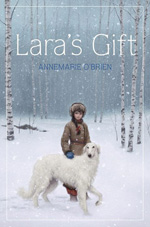 Fourteen-year-old Lara comes of age in 1914 Tsarist Russia where she dreams of being in charge of the borzoi dogs that her father raises for a wealthy count who lives nearby. But the birth of a baby brother prompts her father to start making wedding plans for Lara and to relieve her of her duties in the kennel. To her father's displeasure, Lara experiences visions relating to the dogs, allowing her to know when a litter is going to be born or when the dogs are threatened. Her father fears what will happen to someone with her special gift and insists that she hide it. Lara has strong bonds with all the dogs, but especially with Zar, who she saved as a pup when he was intended to be killed as the runt of the litter. Although he is still smaller than his litter mates, Zar is brave, fast, and determined to pursue the wolves that plague the countryside. Not only brimming with interesting tidbits from Russian history, the book is a tribute to the love between a girl and her dog. The juxtaposition of beauty and savagery in the scenes that occur in the woods between the dogs and the wolves reveals a great deal about the savagery that is a part of nature. Lara’s affection for these special canine breed fills the book’s pages and makes her losses exceptionally difficult. The author deftly describes the relentless snow that fills the woods and makes it hard to move around. As they read, readers will feel an icy wind at their napes.
Fourteen-year-old Lara comes of age in 1914 Tsarist Russia where she dreams of being in charge of the borzoi dogs that her father raises for a wealthy count who lives nearby. But the birth of a baby brother prompts her father to start making wedding plans for Lara and to relieve her of her duties in the kennel. To her father's displeasure, Lara experiences visions relating to the dogs, allowing her to know when a litter is going to be born or when the dogs are threatened. Her father fears what will happen to someone with her special gift and insists that she hide it. Lara has strong bonds with all the dogs, but especially with Zar, who she saved as a pup when he was intended to be killed as the runt of the litter. Although he is still smaller than his litter mates, Zar is brave, fast, and determined to pursue the wolves that plague the countryside. Not only brimming with interesting tidbits from Russian history, the book is a tribute to the love between a girl and her dog. The juxtaposition of beauty and savagery in the scenes that occur in the woods between the dogs and the wolves reveals a great deal about the savagery that is a part of nature. Lara’s affection for these special canine breed fills the book’s pages and makes her losses exceptionally difficult. The author deftly describes the relentless snow that fills the woods and makes it hard to move around. As they read, readers will feel an icy wind at their napes.
- Barbara A. Ward, Washington State University Pullman
These reviews are submitted by members of the International Reading Association's Children's Literature and Reading Special Interest Group (CL/R SIG) and are published weekly on Reading Today Online. The International Reading Association partners with the National Council of Teachers of English and Verizon Thinkfinity to produce ReadWriteThink.org, a website devoted to providing literacy instruction and interactive resources for grades K–12.